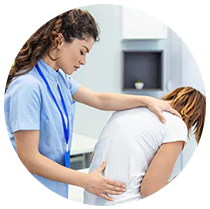Sciatica Nerve Pain Treatment
Overview
Padda Institute center for interventional pain management offers tailored treatments after diagnosing the root cause of the pain. If you feel any symptoms or discomfort, schedule your appointment with one of the best pain management doctors
Sciatica Nerve Pain Symptoms & Characteristics
The symptoms & characteristics of sciatic nerve pain are listed below:
- One Side Pain: The main symptom shows pain in only one leg and wanes.
- Tingling in Legs: The symptom also involves numbness and tingling in the lower extremities. The individual affected also experiences muscle weakness in the lower extremity muscles.
- Excruciating Pain: The main sign that suggests the damage in the sciatic nerve is radiating pain in the low back that goes along the leg and into the feet.
- Extended Hours of Sitting, Standing, and Walking: When there is sciatic nerve pain, the person has difficulty walking, sitting, and performing day-to-day activities.
One of the main signs of sciatica involves pain only on one side of the body. The pain is said to be intense and needs immediate attention.
The main areas affected by Sciatica nerve pain are:
- Sole (of the foot)
- Low back
- Thigh or Leg (Front)

When To See A Doctor?
It is pretty rare when sciatica nerve pain needs immediate emergency attention. Though, a medical emergency is necessary when:
- You are suffering severe pain in your low back, leg, and numbness.
- The patient is facing trouble controlling bowel and bladder movements.
- The pain causes violent injuries such as accidents.

Customized Nerve Pain Treatments
Sciatic Nerve Pain Causes
Spondylolisthesis
Piriformis Syndrome
Herniated Disc
Spinal Stenosis
Diagnosis
Precautions
Exercise Regularly
Change in Lifestyle
Good Posture
The Best Treatment For Sciatica Pain At Padda Institute
Send A Message
Frequently Asked Questions
Typically, sciatica only affects one leg at a time. However, it can impact both legs also. It only matters where in the spinal column, the nerve is being compressed.
Most of the people with sciatica pain recover without surgery. Proper self-care treatments assist in relieving pain. However, it is always advisable to seek a medical expert in case the pain is alleviating.
No, what is commonly referred to as “sciatica” or “sciatica pain” does not just come from the sciatic nerve. Sometimes the lumbar spine’s higher levels are the source of pain, which spreads towards the front of the thighs or the hip region.
Depending on the cause, sciatica pain is described a spiercing, shooting, or jolting in the leg. Others call this discomfort “burning,” “electric,” or “stabbing.” If you stand or sit for longer periods of time, the pain worsens.
A person having following factors might be at a greater risk of sciatica:
- Obesity and overweight
- Lack of strong core to support lower back
- Improper body postures
- Jobs involving heavy weight lifts
- Previous injuries
Usually, sciatica patients fully recover. But a side effect of sciatica can be chronic pain. A “drop foot,” where numbness of the foot makes regular walking impossible, may happen if the pinched nerve is severely damaged. This condition is characterized by chronic muscle weakness. There may be a permanent loss of sensation in the affected leg as a result of sciatica.
Some causes of sciatica, like degenerative disk disease, pregnancy-related sciatica, or unintentional falls, may not be preventable. However, maintaining a proportionate body weight and good posture with regular exercises can help reduce the risks of getting sciatica.
